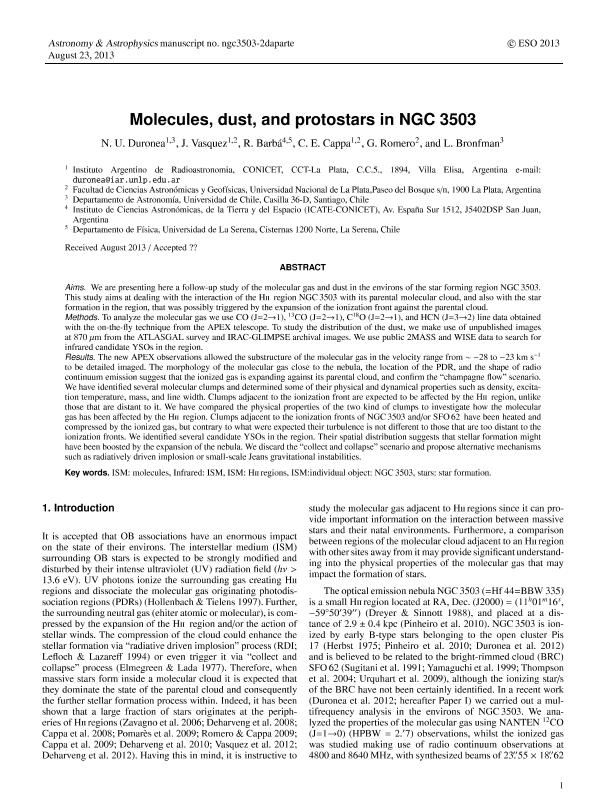Artículo
Molecules, dust, and protostars in NGC 3503
Duronea, Nicolas Urbano ; Vasquez, Javier
; Vasquez, Javier ; Barba, Rodolfo Hector
; Barba, Rodolfo Hector ; Romero, G.
; Romero, G. ; Cappa, Cristina Elisabeth
; Cappa, Cristina Elisabeth ; Bronfman, L.
; Bronfman, L.
 ; Vasquez, Javier
; Vasquez, Javier ; Barba, Rodolfo Hector
; Barba, Rodolfo Hector ; Romero, G.
; Romero, G. ; Cappa, Cristina Elisabeth
; Cappa, Cristina Elisabeth ; Bronfman, L.
; Bronfman, L.
Fecha de publicación:
05/2014
Editorial:
EDP Sciences
Revista:
Astronomy and Astrophysics
ISSN:
0004-6361
Idioma:
Inglés
Tipo de recurso:
Artículo publicado
Clasificación temática:
Resumen
Aims: We present here a follow-up study of the molecular gas and dust in the environs of the star forming region NGC 3503. This study aims at dealing with the interaction of the Hii region NGC 3503 with its parental molecular cloud, and also with the star formation in the region, that was possibly triggered by the expansion of the ionization front against the parental cloud. Methods: To analyze the molecular gas we use CO(J = 2 → 1), 13CO(J = 2 → 1), C18O(J = 2 → 1), and HCN(J = 3 → 2) line data obtained with the on-the-fly technique from the APEX telescope. To study the distribution of the dust, we make use of unpublished images at 870 μm from the ATLASGAL survey and IRAC-GLIMPSE archival images. We use public 2MASS and WISE data to search for infrared candidate young stellar objects (YSOs) in the region. Results: The new APEX observations allowed the substructure of the molecular gas in the velocity range from ~-28 km s-1 to -23 km s-1 to be imaged in detail. The morphology of the molecular gas close to the nebula, the location of the PDR, and the shape of radio continuum emission suggest that the ionized gas is expanding against its parental cloud, and confirm the champagne flow scenario. We have identified several molecular clumps and determined some of their physical and dynamical properties such as density, excitation temperature, mass, and line width. Clumps adjacent to the ionization front are expected to be affected by the Hii region, unlike those that are distant from it. We have compared the physical properties of the two kinds of clumps to investigate how the molecular gas has been affected by the Hii region. Clumps adjacent to the ionization fronts of NGC 3503 and/or the bright rimmed cloud SFO 62 have been heated and compressed by the ionized gas, but their line width is not different from those that are too distant from the ionization fronts. We identified several candidate YSOs in the region. Their spatial distribution suggests that stellar formation might have been boosted by the expansion of the nebula. We discard the collect-and-collapse scenario and propose alternative mechanisms such as radiatively driven implosion on pre-existing molecular clumps or small-scale Jeans gravitational instabilities.
Archivos asociados
Licencia
Identificadores
Colecciones
Articulos(IAR)
Articulos de INST.ARG.DE RADIOASTRONOMIA (I)
Articulos de INST.ARG.DE RADIOASTRONOMIA (I)
Citación
Duronea, Nicolas Urbano; Vasquez, Javier; Barba, Rodolfo Hector; Romero, G.; Cappa, Cristina Elisabeth; et al.; Molecules, dust, and protostars in NGC 3503; EDP Sciences; Astronomy and Astrophysics; 565; 30; 5-2014; 30-48
Compartir
Altmétricas



